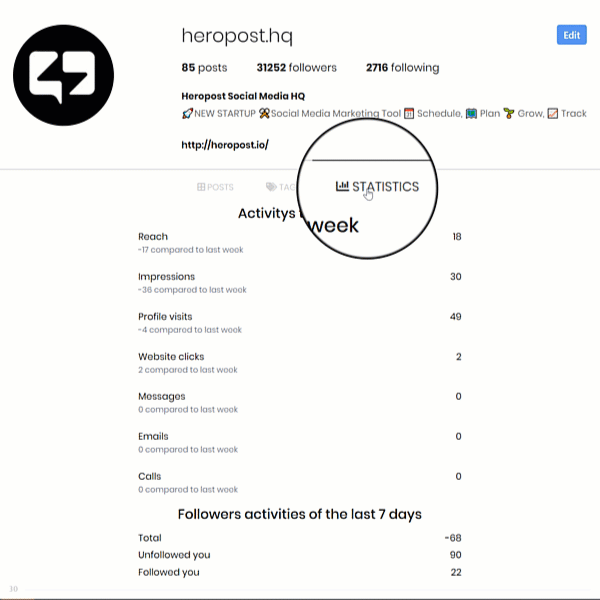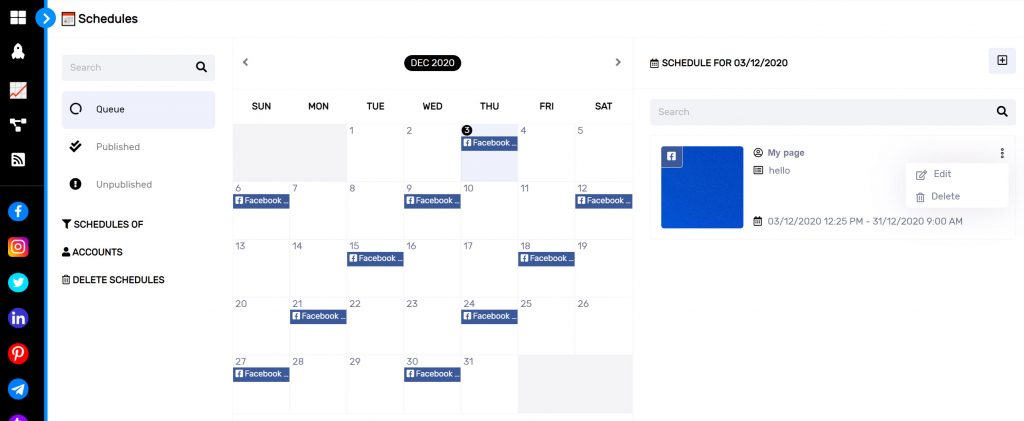 What is social media management?
What is social media management?
Today, most of us are already social media users overall. However, there are differences between managing a brand’s social media presence on a professional level and being an individual social media user. Compared to a personal profile, social media management goes beyond posting to your brand’s social media accounts. In order to manage a company’s social media account, you should firstly know what social media management is.
Social media management is the name given to the specialty that requires professional knowledge and experience in analyzing audiences and implementing certain marketing strategies while creating and publishing content for social media profiles, and connecting with existing and new audiences in deeper ways.
Why is social media management process so important?
Social media enables both individual users and corporate brands to be in constant interaction and communication with their target audience. Social media applications such as Instagram, YouTube, Facebook, Twitter, LinkedIn, and Pinterest are the platforms that provide opportunities to grow your audience and advertising. Efficient social media management is required to be able to successfully implement marketing strategies, increase visits, reach customers, expand your network and influence, raise your brand awareness and increase sales of your products or service.
9 Crucial Benefits of Professional Social Media Management
With efficient social media management, we can take advantage of the following benefits:
- Opportunity to increase the number of the target audience organically
- Analyzing and identifying your target audience
- Consistently creating and publishing content for free
- Increased visibility
- Improving customer support, constant interaction with your customers
- Enhancing your brand by getting noticed on social media
- Finding the right presentation of your products and services according to your audiences’ tastes
- Generating sales
- Maintaining your presence on social platforms and not falling behind your competitors
 How much does social media management cost?
How much does social media management cost?
Social media management services vary in costs. If you want to work with a social media management company, it will charge monthly in most cases. You can expect to pay between $400 and $5,000+ per month. How many channels you have, types of content you want them to create, amount of help you need, etc. will affect the price you’ll pay. And, another option is to hire a freelancer who generally charges by the hour and will be less expensive compared to a company. Depending on the experience of a freelancer, it’s possible to pay between $25 and $120+ per hour.
What is a social media manager?
A social media manager is responsible for establishing and representing a company’s or a public figure’s online presence, enhancing corporate identity, creating and updating the content, getting attention and traffic from the target audience, monitoring interaction and mentions, and reporting business performance.
Top Skills Every Social Media Manager Needs to Have
- Good communication skills are needed to be able to effectively connect with the target audience, which is essential to boost the company’s public figure. A social media manager should know how to influence and impress while interacting with audience.
- Good skills of collaboration is required. Collaborating with marketing colleagues, clients, and influencers is necessary to be in progress.
- Analyzing is essential to run social media accounts. If a social media manager aims to expand a brand’s presence on social platforms, being able to prepare reports of the performance and analyze the results can help compare weaknesses and strengths.
- Creativity and originality can help create high-quality content and come up with attention-grabbing techniques when it comes to implementing marketing strategies, sharing information, increase sales of the products or services.
 How to Get Started with Social Media Management
How to Get Started with Social Media Management
To get started with social media management of your company, here are the significant steps that you should follow:
Picking the Right Social Media Platforms
There are many popular social media channels today. Therefore, using all the popular platforms for your business may sound like a must-do when it comes to improving your presence on social media. However, not every platform works the same for every business. Prioritizing the platforms is important to expand your audience. You should choose the right social media platforms for your business in order to reach your target audience.
Without wasting your time publishing content in every profile you have on different social platforms, you can focus your efforts on the most used social networks by your audiences. Plus, to reach your potential consumers, you should find how to utilize the features each social platform offers to boost your brand’s visibility.
Where can you reach your target audience directly? Finding the most beneficial platforms and checking the demographic data can help you find the right networks for your business. To enhance your brand at social self-promotion, spend your time researching Instagram, Twitter, Facebook, YouTube, and any other platforms. Here are 24 Social Media Sites To Check Out For Your Brand. Determine which suits you the best!

Managing Multiple Social Media Accounts
Even though you chose platforms that work best for your business, it will be hard to manage and keep track of all your different accounts. Running several social media accounts without any help from an organizer tool can make your management process quite complicated over time. And eventually, you will be overwhelmed by the efforts and time you put into organizing all your projects. It’s for sure that putting in time is a requirement for success but why would you waste your energy while you could do all your work directly on a single platform?
Heropost helps you run several social media profiles from one single dashboard, making it easier to access all in one simplified. It enables you to see all the streams at once, as well as post and schedule content for each account you add, and work collaboratively with your teams. Integrating Heropost into your business will save your time, and increase efficiency and productivity as it makes faster to perform through user-friendly interface.

Setting Goals
Determining your strategy firstly starts with setting goals on your way to success. Your goals will help you plan the type of content to create. What do you hope to accomplish? What does your brand need in the long term? Do you expect to bring in new audience or establish brand loyalty?
Make sure your goals are aligned with your expectations but be careful not to set too ambitious goals. Just be realistic and reasonable by starting with what matters most to your brand. It can be beneficial to target dates to achieve your goals and track your progress occasionally.
 Conducting a Social Media Audit
Conducting a Social Media Audit
A social media audit is the analysis of your efforts on social media. It gives you a full view of how well your strategies work and allows measuring your success. You always need an insight into your social media presence to achieve your goals and clarify your strategies. That’s why it is very beneficial to keep track of your accounts. Analyzing past or recent successes and problems in your social media process will improve how you manage your business. If you aren’t satisfied with the results, you can always revise your strategies.
Frequency of your social media audit depends on your needs and current conditions. If you’re new to the platform, it will be better to perform an audit as often as possible to keep on the right track.
How do you perform a social media audit?
Here are the steps to follow:
- Listing all of your profiles in spreadsheet is basically the first step to conducting a social media audit. Don’t forget to make columns for each of your accounts so that you can fill the rest of your spreadsheet in order.
- Metrics are easy to access on every social media platform. Find the data of your profiles, and structure your list with usernames and URLs of your company’s accounts including performance indicators. What do we mean by performance indicators? It is to add columns that contain the number of followers, engagement rates, demographic data, and high-performing content for each social media account you have on the list.

Heropost presents you clear analytics and actively updated reports of your accounts.
- After you’ve done with the spreadsheet, it’s time to examine content preferences, audience growth and visits. What are the features that make your audience click on these top posts? For instance, do they prefer to see videos? What are the trends that they are interested in?
- Compare your current performance to the last time you conducted a social media audit. It will help you see your progress over time. In addition, look at past problems so that you can decrease future risks.
- Review your competitor’s accounts to compare them with your current performance. What are they posting on their profiles? How often do they post? What kind of strategies do they implement? How do they expand their influence?
Identifying Your Target Audience
You want to interact with your target audience but where can you find them? Which platforms do they prefer? Researching and analyzing your audience is necessary to manage your business effectively on social media. It helps you create relevant content, improves your customer relationships stronger, and defines the marketing strategies that you need to execute.
How do you figure out your target audience? Some tips are below:
- Reviewing your current audience and looking at who buys your products or services are the first steps you can do to determine the demography. You should find the main characteristics such as age, gender, income level, location, behavior, and interest. Research your customer statistics on every social media platform you use. Creating customer personas based on your analysis can make it easy to represent your audience types.
- Keeping in touch with your customers is essential to determine what they like. Encourage them to write reviews on your products by asking directly. You can use email automation to ask for feedback and distribute customer surveys. Always pay attention to the results. These will give you a clear insight into your audience.
- Do market research to detect the trends. Gather information about the dynamics of the market within your industry. In this way, you’ll get to know your potential customers, their habits, how much they are willing to pay, and what they are looking for. Also, you’ll find out your competitors’ approaches and strategies so that you’ll compare them with your own brand. Your research will help you understand market conditions, which will guide you in your social media process.
 Implement Your Social Media Strategy
Implement Your Social Media Strategy
Building an effective social media strategy is essential if you aim to lead your business in the right direction. It means every step you take on social media platforms should be planned precisely to bring success.
After you’ve decided which platforms to prioritize and who your audience is, it’s time to develop your social media strategy according to your analysis.
Building a Content Calendar
It is incredibly important to stay active on social media as follower growth is fueled by posting quality content regularly. So, consistency is the key to keeping your audience engaged and growing traffic. However, uploading regular posts on daily basis for each profile you run on social platforms is challenging if you’re planning to post manually on your own every single day. It can be quite a mess when we also consider that you have multiple business accounts. You will probably be confused about what to submit over time, and find it hard to keep on regularly posting.
No need to waste your time while there is an option to add and schedule content for your different social profiles. All you need is an organized way to control consistency on your page.
A content calendar is a visualized version of your content distribution throughout a month or a year. It gives you easy access to visualization of your organized content.
With the help of a content calendar, you schedule posts in detail, organize the date you want to submit and edit when it is needed.

Heropost Content Calendar
Benefits of Creating a Content Calendar:
- Accessing a top-down view of monthly content
- Saving your time by scheduling at once
- Simply producing posts on an ongoing basis
- Planning ahead announcements, events, important dates
- Publishing posts on your audience’s most active times
- Reviewing content long before it is submitted so that you can see if there is inadequacy
- Reorganizing your content

Scheduling content on Heropost
Scheduling
While it helps with several benefits, any new idea can be also added to your content calendar, and you can determine the best time to submit it by finding the gaps in your content calendar. Before submitting your posts, it ensures you will have time to review and approve them.
You can use Heropost Schedules that provides content calendar for your several social channels. It’s efficient for scheduling out numerous social media profiles at once.
For example, you can plan your Instagram posts in a simple and straightforward way.
Here is a How to Guide for Scheduling Instagram Posts.
You can apply the same process to every social platform that you use for your business. You will be sure that your posts on Instagram, Facebook, YouTube, Twitter, Pinterest, etc. are easily scheduled and reliably posted.
 Creating and Publishing Social Media Content
Creating and Publishing Social Media Content
One of the most important parts of running your brand’s accounts on social media is creating and posting regular, high-quality content because content is what attracts social media users and convinces them to follow you. It provides the opportunity to build a loyal following and stay visible to your prospective audience. So, keeping your followers engaged with a variety of content is the key to boosting your brand’s visibility. However, running a business account doesn’t mean you can post whatever you want. Today, billions of content are shared daily on social media networks, yet very few attract attention and stand out for brand awareness. That is why it’s not just sharing content that seems relevant to you but it should be of high quality, original, memorable, and representative of your brand in order to get genuine, better results.
 While creating content and trying to increase effectiveness, you should mainly pay attention to the following advice:
While creating content and trying to increase effectiveness, you should mainly pay attention to the following advice:
- Create suitable content for the target social platform
- Look for content that will last and stay relevant in your industry
- Always stay active and consistent
- Determine how often you should post and how much content you need to create
- Professionally create the texts you will use in your content, follow proper SEO guidelines
- Consider current events
- Use hashtags to seize the opportunity to reach new audience
- Involve content writers, graphic designers, web developers, etc.
- Use professional designer tools such as Canva, Adobe Photoshop, Adobe Illustrator, and Adobe Light Room
- Utilize social media algorithms that can help you gain more post-interaction
- Add Instagram alt text on your images
- Use call to action text when it is needed
- Keep an eye on your content analytics to see what gets attention
Creating content includes writing copy, uploading images and videos. To implement the tips above, create the following types of content:
Copy
While creating your content, you’ll always need a well-written copy or a caption. You should create copy that is reflective of your brand and gets attention from your audience. What makes your brand unique? How can you put your brand into words?
Try to develop content style according to your brand features and distinctive components. Plus, analyzing how your audience speaks in comments can guide you on how to develop your style. You can copy their style by taking notes of what kind of words frequently appear, and use them in your texts. Your selection of words will reflect your caring for the audience. Just make sure it’s clear and easy to read.
 Images
Images
Visuals are the most favored types of content by far and include everything from Facebook videos to Instagram posts. Presenting the right image and representing something relatable to people will surely increase your chances of gaining views, likes, or followers on social media platforms. Establishing a distinct aesthetic for your brand is one of the best ways of maintaining brand consistency across all your channels. Even if your content mostly includes text, offering photos or videos can keep people on your page longer.
You should carefully design your graphics or photos from color schemes to applying filters. Here is a guide to Choosing the Best Colour Scheme for Your Business.
You can work with designers or use designer apps, check out Amazing Photo Editing Apps for Social Media.
Also, you can utilize Sites Offering Free Images for Your Business.

Canva
Videos
Along with images, videos are essential parts of content to raise your profile online. They are great ways to explain your product or service. You can use video types such as:
- Professional videos to create quality
- How-to/tutorial videos to share expertise matching your audience’s interests
- Live streams to interact with your followers
- Social Media Shorts such as Instagram Reels to expand your visitors
- Ephemerals such as Facebook and Instagram Stories
- Vlogs
- Interviews
- Combining images into video
- Animations
 Resonate with Your Audience
Resonate with Your Audience
If your brand offers truly impactful content that resonates with your audience, they can share and download it, which will help you increase organic traffic to your pages. In addition, it will nurture your existing customers.
To spark engagement, it is critical to share content considering what your audience likes. You need to have an understanding of your target audience. You’ll have a clear picture of your audience if you have carried out audience research by far. Start with identifying what type of content they want to consume, and what matches their interests. Determine what kind of content has the potential to drive more qualified traffic to your social accounts.
 User-generated Content
User-generated Content
User-generated content is any content that includes text, videos, images, blogs, reviews, etc., created by your customers. It is one of the best ways to influence users in their purchase decisions. Plus, it means you don’t even have to produce all the content. A third party will promote your brand.
Content created by your buyers leads to a fresh, trustworthy perspective on your brand, and in most cases, users trust recommendations from other consumers more than they do from brands. Other users view these reviews as reliable, authentic, credible sources, which is a great way to earn more followers and clients.
How will you collect user-generated content? Start by asking your followers to contribute, encourage them to get involved with your brand. Ask them to tag your brand on their content so that you can be visible to more people. Ensure they have links and captions to share on your social media accounts. When your consumers start sharing content that includes your brand, you can repost them on your social profiles. Don’t forget to give credits to your consumers.
 Collaborations
Collaborations
Making collaborations with influencers, other brands, publishers, and organizations in your industry is another way of advertising to get attention of your prospective customers and improve your brand awareness, which is a great chance to interact with your partners’ social media audience, which will bring in new followers.
Reach out to influencers, publishers, or trusted organizations in your industry that have significant followings and build relationships with the person behind. Send them free products to review. You can offer sponsorship to promote your products or services, work together to create content for your business, and attract audience.
 Listening and Responding to Your Social Media Followers
Listening and Responding to Your Social Media Followers
Responding to audience on your social media channels is an everyday responsibility as it has a big impact on demonstrating responsive, excellent customer service.
What you need to do is to routinely monitor likes, comments, shares, mentions, and direct messages across your social platforms to see what people say about your brand. Then, respond to them when they ask a question, ask for help, or anything. Put your time and efforts into communicating with your audience.
Interacting with your followers also helps prevent any brand-related social media crises. Always respond to people who leave negative comments, sharing a bad experience. Never leave them in the dark. Reach out to solve their problem, stay in contact. Your approach is important to demonstrate that you care about your consumers, which will bring loyal customers.
 Creating Social Media Advertising
Creating Social Media Advertising
Social media advertising can help you reach more users who are most likely to be interested in your products. It improves your brand visibility and increases engagement.
Major social networks offer various advertising options. For instance, you can check our article Different Types of Facebook Ad Formats to Try Out Today.
In conclusion
Efficient social media management is what you need if you aim to achieve your business goals. All you need to do is set your goals, determine your strategies, create content calendar, publish relevant content, engage your audience, and establish your brand on social media platforms in this way.
Now that you have a high level look into social media management, start managing with Heropost.